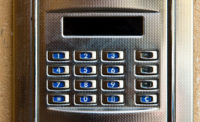Failure to maintain an egress as well as failing to protect people from smoke and fire are all too common, yet easy to discern. Better yet, allare preventable through improved staff performance or implementing affordable solutions.
Hereis a list of ten typical life safety violations along with solutions that can help keep facilities safer for visitors and staff.
1) - Obstructed openings- Sometimes a stopgap solution to excess supplies is to place them next to the door and stock them later. Even in these well-intended situations, visitor and staff safety can be affected since this action may allow the spread of smoke and fire beyond the confines of smoke compartments.
2) Obstructed hallways– Pushcarts, tables and chairscan start to pile up in hallways, preventing impeding access to stairwells and exit doors. Make sure the hallways stay clear.
3) Broken door locks – Although not necessarily a life safety code issue, broken and inoperable door locks can create risks. Not only can broken locks foster opportunities for theft, they may also expose business sensitive information to unauthorized persons. Educate your staff whom to notify in the case of maintenance and be proactive in surveying openings for damage.
4) Improper fire rating on doors - Painted over or missing fire rating labels is consistently a problem issue. Ensuring that painters understand the importance of not covering door and frame labels can significantly reduce the potential for this violation. Where necessary, replace damaged doors with doors that have proper fire ratings. Regardless ofthe training provided to painters or specifications given to companies replacing doors, never close out a project without an inspection and commissioning process.
5) Broken door seals - Wear and tear will affect all doors eventually. A door that might close but not seal properly may allow smoke and fire to penetrate an opening much quicker.
6) Doors that do not properly close - Adoor that doesn't close is a door that can't be latchedor prevent the spread of fire. Often, fixing a broken door is as simple as replacing a broken level or a hingeadjustment.
7) Doors that don't self-close properly - In many places, Life Safety code requires the door to close and latch on its own without impediment. If doors are designed to close and latchon without human intervention but fail to do so, the closershould be repaired or replaced immediately.
8) Worn door hardware – Loose hardware that could fail, corroded hinges that could snap or worn levers that can catch on clothing should all be replaced or repaired.
9) Missing or unmarked designated fire exits– Exits and exit egress pathways that are not clearly marked create a dangerous condition, particularly in smoke-filled hallways. In an emergency, occupants need to have to have clearly designated and identified egress routes.
10) The devil is in the details– The smallest infraction can endanger the safety of your occupants. Be thorough.


